
Joseph Mallord William Turner, known in his time as William Turner, was an English Romantic painter, printmaker and watercolourist. He is known for his expressive colouring, imaginative landscapes and turbulent, often violent marine paintings. He left behind more than 550 oil paintings, 2,000 watercolours, and 30,000 works on paper. He was championed by the leading English art critic John Ruskin from 1840, and is today regarded as having elevated landscape painting to an eminence rivalling history painting.

John Julius Angerstein was a London businessman and Lloyd's underwriter, a patron of the fine arts and a collector. It was the prospect that his collection of paintings was about to be sold by his estate in 1824 that suddenly galvanised the King, George IV, and the prime minister, Lord Liverpool, into purchasing his collection for the nation and led to the founding of the British National Gallery in Angerstein's house at 100 Pall Mall.
Events in the year 1809 in Art.
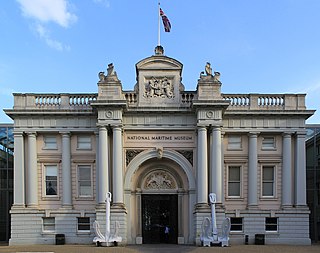
The National Maritime Museum (NMM) is a maritime museum in Greenwich, London. It is part of Royal Museums Greenwich, a network of museums in the Maritime Greenwich World Heritage Site. Like other publicly funded national museums in the United Kingdom, it has no general admission charge; there are admission charges for most side-gallery temporary exhibitions, usually supplemented by many loaned works from other museums.

Queen's House is a former royal residence built between 1616 and 1635. It was built near the now demolished Greenwich Palace, a few miles downriver from the City of London and is now in the London borough of Greenwich. It presently forms a central focus of what is now the Old Royal Naval College with a grand vista leading to the River Thames. The Queen's House architect, Inigo Jones, was commissioned by Queen Anne of Denmark in 1616 and again to finish the house in 1635 by Queen Henrietta Maria. The Queen's House was commissioned by both Anne and Henrietta as a place to display artworks they had accumulated and commissioned; this includes a ceiling of the Great Hall that features a work by Orazio Gentileschi titled Allegory of Peace and the Arts.

Kew Bridge is a wide-span bridge over the Tideway linking the London Boroughs of Richmond upon Thames and Hounslow. The present bridge, which was opened in 1903 as King Edward VII Bridge by King Edward VII and Queen Alexandra, was designed by John Wolfe-Barry and Cuthbert A Brereton. Historic England listed it at Grade II in 1983.

Ranger's House is a medium-sized red brick Georgian mansion in the Palladian style, adjacent to Greenwich Park in the south east of London. It is situated in Blackheath and backs directly onto Greenwich Park. Previously known as Chesterfield House, its current name is associated with the Ranger of Greenwich Park, a royal appointment; the house was the Ranger's official residence for most of the 19th century. It is a Grade I listed building. There is a rose garden behind it, and since 2002 it has housed the Wernher Collection of art.

The Battle of Trafalgar, 21 October 1805 is an 1822 painting by British artist J. M. W. Turner. It was commissioned by King George IV as a part of a series of works to decorate three state reception rooms in St James's Palace and link the Hanoverian dynasty with military success. This work was Turner's only royal commission, and was to stand as the pendant piece to Philippe-Jacques de Loutherbourg's Lord Howe's action, or the Glorious First of June. This massive history painting measures 2,615 millimetres x 3,685 millimetres and is his largest work. It was given to Greenwich Hospital shortly after its original installation. The painting now hangs in the National Maritime Museum, also in Greenwich, London.
Events in the year 1824 in Art.

Joseph Barney, was a British painter and engraver. He is usually described as a pupil of Antonio Zucchi and Angelica Kauffman and as a fruit and flower painter to the Prince Regent.
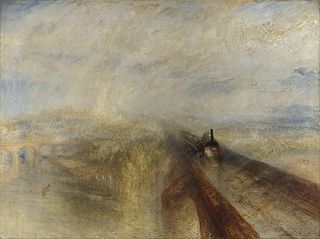
Rain, Steam, and Speed – The Great Western Railway is an oil painting by the 19th-century British painter J. M. W. Turner.
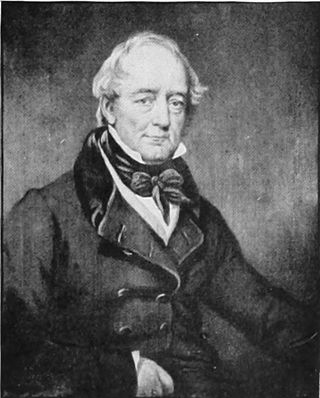
Charles Turner was an English mezzotint engraver and draughtsman who specialized in portraiture. He collaborated with J. M. W. Turner on the early plates of the same's Liber Studiorum.

Light and Colour – The Morning after the Deluge – Moses Writing the Book of Genesis is an oil painting by the English painter Joseph Mallord William Turner (1775–1851), first exhibited in 1843.

Snow Storm: Hannibal and his Army Crossing the Alps is an oil on canvas painting by J. M. W. Turner, first exhibited in 1812. Left to the nation in the Turner Bequest, it was acquired by the National Gallery in London in 1856, and is now held by the Tate Gallery.

Dido building Carthage, or The Rise of the Carthaginian Empire is an oil on canvas painting by J. M. W. Turner. The painting is one of Turner's most important works, greatly influenced by the luminous classical landscapes of Claude Lorrain. Turner described it as his chef d'oeuvre. First exhibited at the Royal Academy summer exhibition in 1815, Turner kept the painting until he left it to the nation in the Turner Bequest. It has been held by the National Gallery in London since 1856.

Musidora: The Bather 'At the Doubtful Breeze Alarmed', also known as The Bather, is a name given to four nearly identical oil paintings on canvas by English artist William Etty. The paintings illustrate a scene from James Thomson's 1727 poem Summer in which a young man accidentally sees a young woman bathing naked and is torn between his desire to look and his knowledge that he ought to look away. The scene was popular with English artists as it was one of the few legitimate pretexts to paint nudes at a time when the display and distribution of nude imagery was suppressed.

Montagu House was a prominent residence situated near to the southwest corner of Greenwich Park, overlooking the common at Blackheath in what is today southeast London. Adjacent to the Ranger's House, it was the royal residence of Caroline of Brunswick before being demolished in 1815.
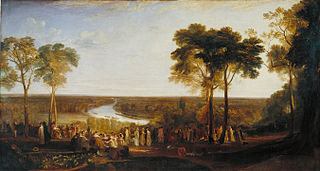
England: Richmond Hill, on the Prince Regent's Birthday is an 1819 painting by the English artist J. M. W. Turner. It was displayed at the 1819 Royal Academy Summer Exhibition at Somerset House, the largest work that Turner had yet presented. It depicts a real event on Richmond Hill hosted by Lady Cardigan at Cardigan House on 12 August 1817 to celebrate the birthday of the Prince Regent. Petersham Meadows by the bend in the River Thames is in the background. Just across the river in Twickenham was Turner's own house Sandycombe Lodge. Ham House is also visible in the distance. The work appears to show the Regent just off the canvas as several of the guests turn to look. Turner's biographer James Hamilton describes it as featuring "flighty Watteauesque figures, ideal evanescent trees, and a horizon so extended as to be unreal". It may have been an attempt to secure the Regent's patronage. He did subsequently receive his only royal commission for the naval painting The Battle of Trafalgar in 1822.
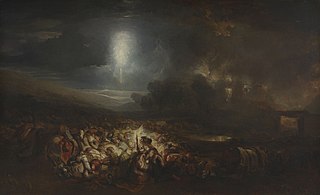
The Field of Waterloo is an 1818 history painting by the English artist J. M. W. Turner. It portrays the aftermath of the Battle of Waterloo which took place on 18 June 1815. Rather than the triumphal depictions commonplace in portrayals of the battle, it functions more as an elegy to Waterloo's unknown victims. In 1817 Turner visited the site of the battlefield and drew a number of sketches. In the background is the ruined remains of the farmhouse at Hougoumont which had played a pivotal role in the fighting. It was exhibited at the Royal Academy Summer Exhibition at Somerset House that year along with some lines from Lord Byron's poem Childe Harold's Pilgrimage "friend, foe, in one red burial blent". Part of the 1856 Turner Bequest it is now in the Tate Britain in London.

The Funeral of Sir Thomas Lawrence is an 1830 watercolour painting by the British artist J. M. W. Turner. It depicts the funeral at St. Paul's Cathedral in London of Sir Thomas Lawrence, the President of the Royal Academy and a friend and colleague of Turner. Lawrence died unexpectedly in January, and the painting captures the snow-covered landscape of his burial ceremony. Turner served as one of the pallbearers and sketched the scene from memory. It was exhibited at the Royal Academy's Summer Exhibition. It was later part of the 1856 Turner Bequest as is now in the collection of the Tate Britain.



















